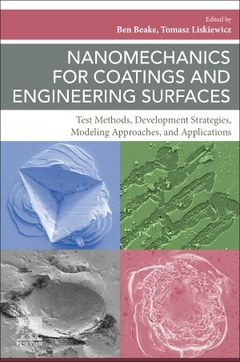Description
Nanomechanics for Coatings and Engineering Surfaces
Test Methods, Development Strategies, Modeling Approaches, and Applications
Coordinators: Beake Ben, Liskiewicz Tomasz
Language: English
Subjects for Nanomechanics for Coatings and Engineering Surfaces:
660 p. · 15x22.8 cm · Paperback
Description
/li>Contents
/li>Biography
/li>Comment
/li>
Nanomechanics for Coatings and Engineering Surfaces: Test Methods, Development Strategies, Modeling Approaches, and Applications provides readers with an array of best practices for nanoindentation measurements as well as related small-scale test methods and how to translate test results into the development of improved coatings. A core theme of the book is explaining to readers exactly how, when, and why the nanomechanical properties of engineered surfaces relate to their wear resistance. The book starts with chapters that introduce the development and importance of nanomechanical testing and linkages between wear resistance and the mechanical properties of coatings before moving into discussions of various experimental methods and techniques, such as nanoindentation, continuous stiffness measurements, nano-scratch methods, high-temperature testing, nano-impact testing, and more. Other sections discuss modeling approaches such as finite element analysis, atomistic and molecular dynamics, and analytical methods. Design strategies and industrial applications are covered next, with a final section looking at trends and future directions.
Section 1: Introduction 1. Development of nanomechanical testing 2. Development of additional nano-scale wear test techniques 3. Linking coating mechanical properties and wear resistance Section 2: Experimental Methods/Techniques 4. Nanoindentation - strategies for reliable measurements on coated systems 5. Indentation Energy-based Analysis Methods 6. Nano-scratch testing 7. Reciprocating Nano- and Micro-scale Wear Testing 8. AFM nano-wear 9. Nano-impact testing 10. Micro and Nano-mechanics to understand the effects of residual stress on a coating's performance 11. Multi-sensing Approaches 12. High temperature testing Section 3: Modelling Approaches 13. Analytical methods 14. Numerical simulation and Finite Element Analysis 15. Atomistic and Molecular Dynamics Section 4: Coating and Engineering Surfaces: design strategies and industrial applications 16. H/E Revisited 17. Thin protective coatings on silicon for MEMS 18. DLC on steel for automotive applications 19. High speed machining 20. Nuclear materials 21. Aerospace coatings 22. Solid lubricants 23. Nanomechanics of Tribologically Transformed Surfaces 24. Microtribology Experiments for Hard Metals Section 5: Summary 25. Trends and future directions
Ben is currently a Visiting Professor in Mechanical Engineering, University of Leeds, and the University of Huddersfield. He is very active in collaborative research with other NanoTest users with over 100 published papers in:
Developing new nano-mechanical test methods
Applying them to study mechanical and tribological properties of thin films and coatings
Environmental sensitivity in polymers
Professor Tomas Liskiewicz is Head of Department of Engineering at Manchester Metropolitan University. He has over 20 years of international academic and engineering experience from leading research institutions in the UK, France, Canada, and Poland. His research interests focus on surface engineering and tribology of functional surfaces, with a particular interest in fretting wear phenomena. His work has been published in such journals as Applied Surface Engineering; Tribology International; Surface and Coatings Technology; Wear and Industrial & Engineering Chemistry Research. He has presented at an array of international conferences and has been involved in fretting research for 20 years, with a main focus on wear processes. He previously spent 2 years in Alberta, Canada, working as a Senior Scientist at Charter Coating, leading material testing projects for the oil and gas industry. He was elected Fellow of the Institution of Mechanical Engineers in London in 2014 and is a Fellow of the Institute of Physics in London where he acts as Chair of the Tribology Group Committee.
- Provides best practices in nanoindentation measurements and related small-scale test methods
- Demonstrates how to use test results to develop improved coatings
- Outlines modeling approaches and numerical simulations
- Highlights selected applications for metallic nanocomposites, tribological coatings, solid lubricants, and aerospace coatings
- Shows future directions for simulation of complex wear scenarios
These books may interest you

Handbook of Micro/Nano Tribology 71.13 €

Nanoindentation of Brittle Solids 232.80 €


